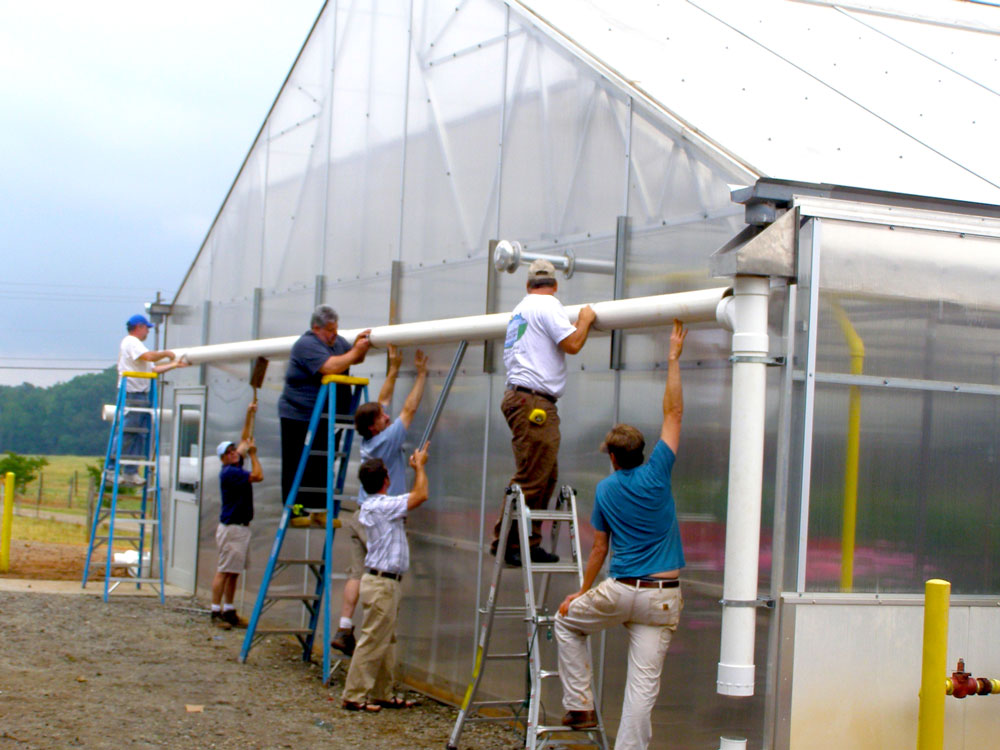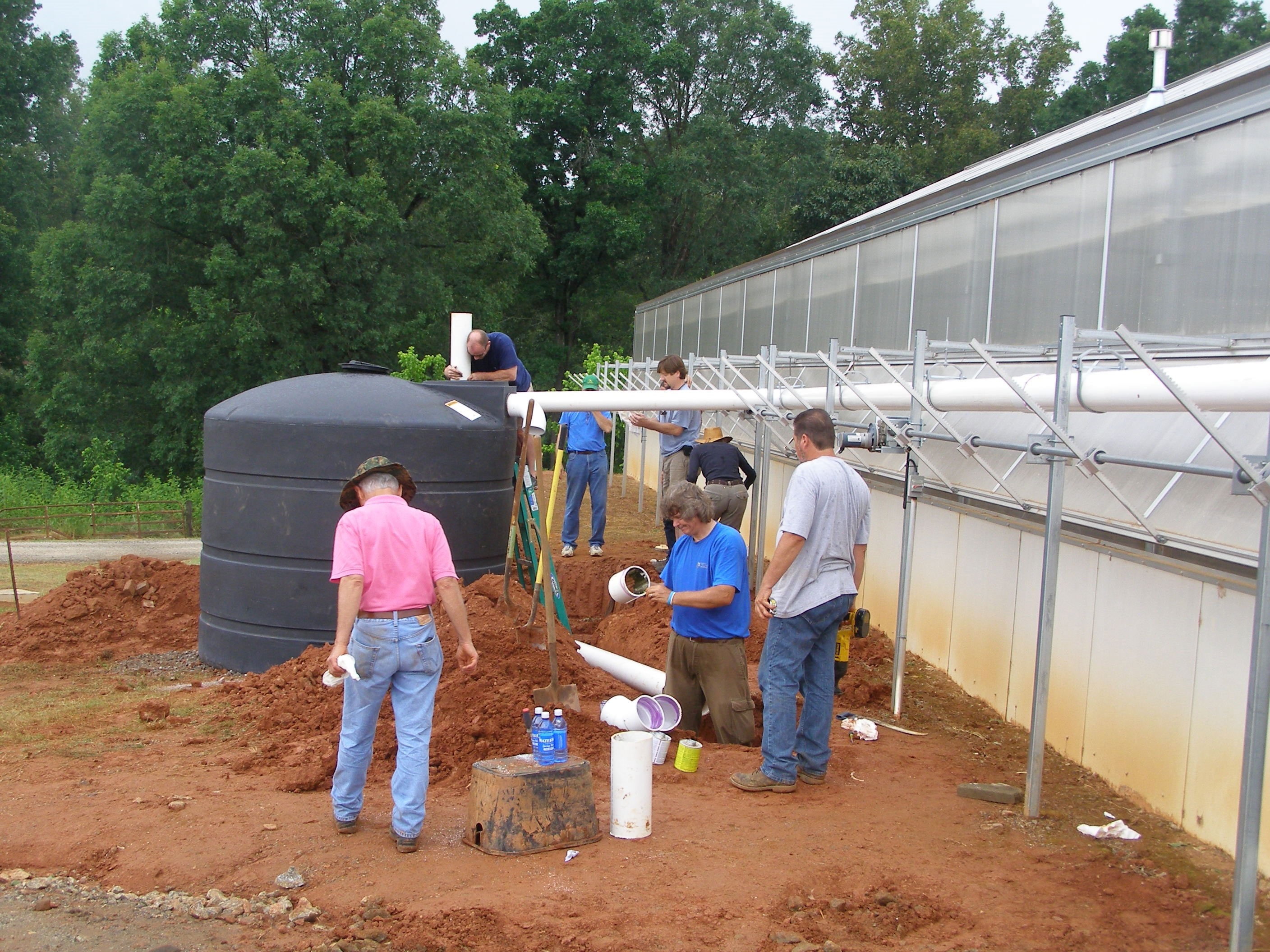
PHOTOS COURTESY OF BILLY KNIFFEN
In an era where climate change reshapes our relationship with natural resources, finding sustainable solutions for food production is more important than ever. One of the most promising approaches is integrating rainwater harvesting into greenhouse gardening. This practice not only secures a reliable water source but also nurtures resilience and self-sufficiency in the face of water scarcity.
Greenhouses offer an ideal environment for growing plants, extending growing seasons, and protecting crops from harsh weather. Yet, they can be heavy water consumers, especially in dry or arid regions. That’s where rainwater harvesting comes into play — capturing and storing rainwater for irrigation. It’s a simple concept with profound benefits. By using harvested rainwater, growers can reduce their reliance on municipal water, lower utility costs, and decrease environmental impacts like runoff and soil erosion. Moreover, this practice aligns with eco-conscious values, helping to mitigate the strain on local water supplies while fostering healthier ecosystems.
But beyond the environmental benefits, rainwater offers distinct advantages for plant health. Unlike treated municipal water, which often contains chlorine, fluoride, and other additives, rainwater is pure and chemical-free. It carries a slightly acidic pH, usually around 5.6, which aligns with the preferences of most plants. This balance helps maintain healthy soil and ensures plants absorb nutrients more efficiently. Soft by nature, rainwater supports a healthier root system and encourages better nutrient uptake by avoiding many of the issues associated with treated water.
There are numerous reasons why rainwater is the preferred choice for irrigation. First, it lacks the chemical treatments found in most tap water. Over time, the chlorine and additives in treated water can accumulate in the soil, disrupting the microbial life that plays a crucial role in plant nutrition. These microbes break down organic matter, making nutrients more accessible to plants. By using rainwater, greenhouse growers support a thriving soil ecosystem, which in turn enhances plant growth naturally.

Rainwater harvesting in action: A functional greenhouse setup featuring gutter-connected collection systems, exemplifying efficient rainwater capture for sustainable irrigation.
Rainwater is also softer than most municipal sources, containing fewer dissolved salts and minerals. Hard water may disrupt soil chemistry, which can interfere with root function and nutrient absorption. This can result in stunted growth and reduced yields. In contrast, soft rainwater ensures that plants receive moisture without the complications of unwanted mineral deposits, maintaining optimal soil conditions for healthy growth.
Another advantage of using rainwater is its contribution to better soil health. Municipal water, especially in areas with high mineral content, can cause soil salinity issues over time. Excess salts hinder plant growth, reduce water absorption, and disrupt microbial life. Rainwater helps preserve the soil’s natural structure, promoting root development and overall plant vitality. Additionally, rainwater contains natural nitrogen compounds, like nitrates, which act as a mild fertilizer, encouraging lush, green growth. This reduces the need for synthetic fertilizers and supports a more organic growing approach.
Across the world, various greenhouse operations have successfully adopted rainwater harvesting to meet their water needs sustainably. In regions like Arizona and New Mexico, where water scarcity is a persistent challenge, community green-houses have turned to innovative rainwater harvesting solutions. Large cisterns collect and store rainfall, while automated drip irrigation systems ensure efficient water distribution. These greenhouses not only conserve precious resources but also empower local communities to maintain food production year-round.

Integrated sustainability: This greenhouse demonstrates how captured rainwater can be directed back to a cistern along the side of the greenhouse.
In urban environments, rooftop greenhouses are setting a precedent for sustainable food systems. Cities like New York and Chicago have seen a rise in greenhouses that capture rainwater from surrounding buildings. This approach not only reduces dependence on municipal water but also contributes to urban sustainability by lowering runoff and easing the burden on drainage systems. These rooftop farms provide fresh produce to local communities, creating a cycle of sustainability that benefits both people and the planet.
On a smaller scale, homesteaders in rural areas often use simple systems to harvest rainwater for their greenhouses. Rain barrels connected to gutter systems collect water, which is then used to irrigate plants. While modest in setup, these systems offer a reliable water source that supports year-round growing without tapping into external supplies. These growers often pair their rainwater harvesting systems with organic farming practices, emphasizing a holistic, eco-friendly approach to agriculture.
Of course, integrating rainwater harvesting into greenhouse gardening isn’t without challenges. In regions where rainfall is limited, growers may need to supplement with gray water or well water to ensure consistent irrigation. In colder climates, storage tanks must be insulated, or placed underground, to prevent freezing during winter months. Another consideration is regulatory restrictions. Some jurisdictions have specific rules governing rainwater collection, so it’s important to research and comply with local regulations before installing a system.
Addressing these challenges requires thoughtful planning and adaptability. For example, using first-flush diverters can help ensure that collected rainwater is clean by discarding the initial runoff that may contain debris. Installing filtration systems and regularly maintaining storage tanks can further improve water quality. Insulating tanks or situating them in temperature-controlled environments helps maintain water accessibility throughout colder months. Moreover, working with local authorities can clarify legal considerations and support the development of community-wide initiatives for sustainable water use.
Rainwater harvesting isn’t just about water conservation; it’s about building resilience. It empowers growers to work with nature, reduce dependency on external resources, and cultivate healthier plants. Whether you’re tending a small backyard greenhouse or managing a large urban farm, embracing this sustainable practice ensures a thriving, eco-friendly growing space. It represents a commitment to stewardship, not only of personal gardens but of shared environmental futures.
By tapping into nature’s gift, rainwater, greenhouse growers can nurture crops year-round while stepping lightly on the planet. It’s a simple shift with lasting rewards — for the environment, the community, and the future of food production. Embracing rainwater harvesting is more than just a practical choice; it’s a meaningful step towards a more sustainable and resilient way of life.
Last modified: July 1, 2025

